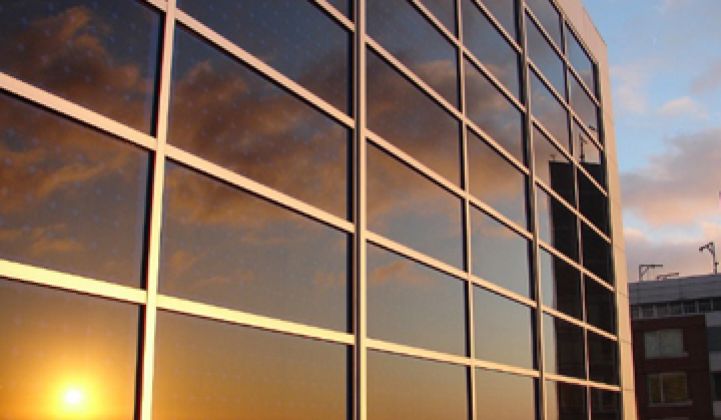Building-integrated photovoltaics (BIPV) has been the last desperate business plan gasp of many solar firms.
Faced with insurmountable cost and scaling pressures, solar firms with non-viable cost structures land their hopes on the promise of BIPV rescuing them from their spiral of doom.
Most of these firms have only a vague idea of what BIPV is and an even less informed route to market.
We're not talking building-applied photovoltaics (BAPV) from the likes of Lumeta or ECD or Ascent or Global Solar or SoloPower. BAPV are lightweight, flexible solar cells adhered onto flat or raised seam roofs, and that product strategy has its own share of technical and cost challenges. That's not really BIPV.
The only way to realize actual BIPV -- and let's define that as solar power sources that are an integral, structural part of the building envelope or facade -- is to be active in the architecture and early design of the building, consulting on matters as integral as the compass orientation of the building.
So today's announcement that eIQ Energy is partnering with Abound Solar and architectural firm Focus Materials to offer solar glass curtain walls for new building construction and renovations is at least a small sign of market understanding by the three parties.
According to eIQ, the system uses eIQ Energy's DC-DC converter product and Abound's cadmium telluride (CdTe) semi-transparent solar panels to create a custom PV curtain wall to generate some of the building's electricity requirements. A curtain wall is a modular, pre-assembled window unit for commercial buildings. The press release claims that the PV capability adds 30 percent to the cost of the curtain wall. Incentives might reduce that further.
The presence of an architectural firm in the mix signals that the trio understands that BIPV has to start at building conception -- it can't be solar panels slapped on the side on a structure. And the presence of eIQ is encouraging -- this type of installation doesn't work very well with standard central inverters; distributed electronics is a better way to go.
If the idea of solar on a west-facing vertical wall seems inefficient, it's certainly not optimal, but this study from altPower indicates the energy and carbon benefits associated with that type of orientation. AltPower has done some of the more interesting BIPV designs in the U.S.
Firms like Pythagoras Solar and Stellaris are incorporating a low-concentration PV piece to building windows or skylights. The Pythagoras windows have their own aesthetic challenges, although they do provide a thermal barrier. Soltecture (formerly SulfurCell) is looking at the BIPV and architectural market for their CIS modules, but that looks more like a small, high-cost structured European solar firm retreating from the merchant module fray so as not be flayed like Q-Cells.
There's also the organic solar cell folks such as Konarka or Plextronics, as well as Dyesol, EPFL, G24i, Mitsubishi and Peccell on the dye-sensitized-cells front. Unable to compete in the module business, they too aspire to potentially large BIPV markets. In almost all cases, however, their low efficiency and questionable reliability will leave them in the press release business as opposed to the power production business.
Here's the bottom line on BIPV and curtain wall:
- The specs for PV curtain wall will stem from architects and building designers. In many cases, these folks are artistes and will not settle for allowing the standard-sized solar panel dimension to define the size of their window. That will require custom size panels or numerous custom sizes. Please ask Abound or any solar panel maker to start making a variety of custom-sized modules. It will never happen. Production line processes and economics cannot support that level of customization.
- If each custom size requires a separate UL approval process, be prepared for a long and deeply unsatisfying relationship with Underwriters Labs.
- Watch out for the skyscraper being built across the street that blocks the majority of the sunlight reaching your structure.
I actually believe BIPV curtain wall is doable and worth doing in some cases. But the expertise will come from the curtain wall and building trade, not from the solar industry.



